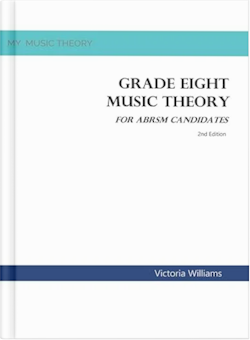Introduction to Grade Eight ABRSM Music Theory
Grade 8 is the final level of music theory offered by the ABRSM as an examination subject. (Higher diploma levels are available from Trinity however).
At this level, you are studying topics similar to those studied at undergraduate level at a UK university.
On this page you can find the syllabus information, and links to the free and paid ABRSM Grade 8 Music Theory lessons available on this site.
You will find a large number of free lessons on this website, or get the full ABRSM Grade 8 Music Theory course in your preferred format:
ABRSM Grade 8 Free Music Theory Lessons
Chords and Keys
- Chords (ABRSM Grade 8)
- Extended Dominant Chords
- Chromatic Chords
- Borrowed Chords and Parallel Keys
- Augmented 6th Chords
- Secondary Dominants
- Other Chromatic Chords
- Distant Modulation
- Identifying Prevailing Key
Figured Bass
Voice Leading
Harmony and Decoration
Trio Sonatas
- Trio Sonatas – Introduction (ABRSM Grade 8)
- Step 1: Dissonances (Trio Sonatas)
- Step 2: Leading Notes (Trio Sonatas)
- Step 3: Roots, 3rds and 5ths (Trio Sonatas)
- Step 4: Patterns (Trio Sonatas)
- Step 5: Momentum (Trio Sonatas)
Keyboard Reconstruction
- Keyboard Reconstruction (ABRSM Grade 8)
- Working with the Harmony (Keyboard Reconstruction)
- Using 2nd Inversions (Keyboard Reconstruction)
- Texture and Part-Writing (Keyboard Reconstruction)
- Voice Leading and Consecutives (Keyboard Reconstruction)
- Notation (Keyboard Reconstruction)
- Phrase, Patterns and Sequences (Keyboard Reconstruction)
- Writing Alberti Bass
Composition
- Composition (ABRSM Grade 8)
- Analysing the Given Opening (Composition Grade 8)
- Creating a Structure (Composition Grade 8)
- Adapting a Melodic Idea (Composition Grade 8)
- Modulation (Composition Grade 8)
- Idiomatic Writing (Composition Grade 8)
- Composition Walkthrough
Practice Test
Grade 8 ABRSM Free Practice Test
Grade 8 tests your knowledge and skills in harmony, composition and general knowledge through a variety of questions.
The exam begins with a Baroque Trio Sonata, which needs to be completed according to the instructions in the figured bass and should conform to the typical Baroque style. This question tests your ability to interpret the figuring, to notice patterns and sequences and apply them appropriately elsewhere, and to obey the rules of harmony that were practised during the Baroque period.
Question 2 requires you to complete a keyboard piece from the given skeleton framework, usually from the Romantic era. You are provided with example bars and harmony, and are tested on your ability to write in the same character throughout, while still obeying the conventions of harmony and in an appropriate keyboard style.
The third question in the exam is a composition piece. You will be given the opening melodic ideas of two pieces and need to choose one to continue into a fully formed piece. You will be tested on your ability to adapt the given opening, fitting a strong melody to a good harmonic framework built of phrases and cadences, as well as writing in an idiomatic style suitable for the instrument. You will be expected to structure the composition in a logical manner, and to include changes of key.
The final two questions in the exam use musical scores to test a wide range of general knowledge questions in music theory. Usually you will be presented with one score for a chamber work, such as a sonata or string quartet, and another for a larger orchestral work. Questions normally cover a variety of topics such as chords, key and harmony, intervals, transposition, knowledge of notation, special symbols and foreign terms, style and compositional techniques, and knowledge of the standard and extended orchestral families.
Grade 8 is a challenging exam, but one which you will find interesting and useful. The skills you learn at this level will help you to make sense of a large variety of music as both a listener and a player, and for those who are interested in composition, there are plenty of techniques covered to help you extend your skillset.
For more information about the ABRSM exams in general, visit www.abrsm.org
ABRSM Syllabus (Grade 8)
As in preceding grades, with the following additions:
- The harmonic vocabulary will include all standard diatonic and chromatic chords.
Questions will cover:
- Continuation of a given opening of a passage from a Baroque trio sonata for two treble instruments and basso continuo. The basso continuo part will be given throughout and fully figured (but a realisation for keyboard will not be required).
- Completion of an outline of a short passage for keyboard. Some knowledge of the styles practised by composers from the time of Haydn onwards will be assumed.
- Continuation of a given opening of a melody for a specified instrument (a choice will be given).
- Questions on short extracts of music written for piano or in open score for voices or for any combination of instruments and/or voices, designed to test the candidate’s knowledge of the elements and notation of music, including the realization of ornaments, the identification and notation of underlying harmonic structure, phrase structure, style, performance, and on the voices and instruments for which the works were written.
Read the ABRSM syllabus here.


